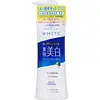What's inside
What's inside
 Key Ingredients
Key Ingredients

No key ingredients
 Benefits
Benefits

 Concerns
Concerns

 Ingredients Side-by-side
Ingredients Side-by-side

Water
Skin ConditioningGlycerin
HumectantButylene Glycol
HumectantDipropylene Glycol
HumectantHydrogenated Polyisobutene
EmollientAlcohol Denat.
AntimicrobialHydrogenated Castor Oil Hydroxystearate
Skin ConditioningTriethylhexanoin
MaskingHydrogenated Lecithin
EmulsifyingDimethicone
EmollientAstaxanthin
Skin ConditioningRosa Canina Fruit Oil
EmollientGlycosyl Trehalose
Emulsion StabilisingSuccinoyl Atelocollagen
Skin ConditioningPunica Granatum Extract
AstringentHydrogenated Starch Hydrolysate
HumectantSodium Hydroxide
BufferingEthylparaben
PreservativePhenoxyethanol
PreservativeMethylparaben
PreservativeParfum
MaskingCaramel
Cosmetic ColorantWater, Glycerin, Butylene Glycol, Dipropylene Glycol, Hydrogenated Polyisobutene, Alcohol Denat., Hydrogenated Castor Oil Hydroxystearate, Triethylhexanoin, Hydrogenated Lecithin, Dimethicone, Astaxanthin, Rosa Canina Fruit Oil, Glycosyl Trehalose, Succinoyl Atelocollagen, Punica Granatum Extract, Hydrogenated Starch Hydrolysate, Sodium Hydroxide, Ethylparaben, Phenoxyethanol, Methylparaben, Parfum, Caramel
Butylene Glycol
HumectantGlycerin
HumectantAscorbyl Glucoside
AntioxidantSodium Hyaluronate
HumectantMagnesium Ascorbyl Phosphate
AntioxidantRoyal Jelly Extract
Skin ConditioningSoluble Collagen
HumectantAcrylic Acid
Isohexadecane
EmollientDisodium EDTA
Polyvinylalcohol Crosspolymer
Squalane
EmollientPentaerythrityl Tetraethylhexanoate
EmollientPolyoxymethylene Melamine
Dimethicone
EmollientDisodium Phosphate
BufferingSodium Hydroxide
BufferingHydrogenated Phosphatidylcholine
EmulsifyingPhenoxyethanol
PreservativeMethylparaben
PreservativeButylene Glycol, Glycerin, Ascorbyl Glucoside, Sodium Hyaluronate, Magnesium Ascorbyl Phosphate, Royal Jelly Extract, Soluble Collagen, Acrylic Acid, Isohexadecane, Disodium EDTA, Polyvinylalcohol Crosspolymer, Squalane, Pentaerythrityl Tetraethylhexanoate, Polyoxymethylene Melamine, Dimethicone, Disodium Phosphate, Sodium Hydroxide, Hydrogenated Phosphatidylcholine, Phenoxyethanol, Methylparaben
Ingredients Explained
These ingredients are found in both products.
Ingredients higher up in an ingredient list are typically present in a larger amount.
Butylene Glycol (or BG) is used within cosmetic products for a few different reasons:
Overall, Butylene Glycol is a safe and well-rounded ingredient that works well with other ingredients.
Though this ingredient works well with most skin types, some people with sensitive skin may experience a reaction such as allergic rashes, closed comedones, or itchiness.
Learn more about Butylene GlycolDimethicone is a type of synthetic silicone created from natural materials such as quartz.
What it does:
Dimethicone comes in different viscosities:
Depending on the viscosity, dimethicone has different properties.
Ingredients lists don't always show which type is used, so we recommend reaching out to the brand if you have questions about the viscosity.
This ingredient is unlikely to cause irritation because it does not get absorbed into skin. However, people with silicone allergies should be careful about using this ingredient.
Note: Dimethicone may contribute to pilling. This is because it is not oil or water soluble, so pilling may occur when layered with products. When mixed with heavy oils in a formula, the outcome is also quite greasy.
Learn more about DimethiconeGlycerin is already naturally found in your skin. It helps moisturize and protect your skin.
A study from 2016 found glycerin to be more effective as a humectant than AHAs and hyaluronic acid.
As a humectant, it helps the skin stay hydrated by pulling moisture to your skin. The low molecular weight of glycerin allows it to pull moisture into the deeper layers of your skin.
Hydrated skin improves your skin barrier; Your skin barrier helps protect against irritants and bacteria.
Glycerin has also been found to have antimicrobial and antiviral properties. Due to these properties, glycerin is often used in wound and burn treatments.
In cosmetics, glycerin is usually derived from plants such as soybean or palm. However, it can also be sourced from animals, such as tallow or animal fat.
This ingredient is organic, colorless, odorless, and non-toxic.
Glycerin is the name for this ingredient in American English. British English uses Glycerol/Glycerine.
Learn more about GlycerinMethylparaben is a preservative and is a paraben. It is used to prevent the growth of fungus, mold, and other harmful bacteria. Parabens are chemicals used as preservatives in both cosmetics and food.
Methylparaben can be synthetically created. It can also be found naturally in some fruits, such as blueberries.
Oftentimes, Methylparaben is combined with other parabens to help increase the shelf life.
The safety of Methylparaben is currently being studied. While ongoing studies are looking into the safety of parabens, the results have been very mixed. Some studies have not found Methylparaben to be harmful.
Learn more about MethylparabenPhenoxyethanol is a preservative that has germicide, antimicrobial, and aromatic properties. Studies show that phenoxyethanol can prevent microbial growth. By itself, it has a scent that is similar to that of a rose.
It's often used in formulations along with Caprylyl Glycol to preserve the shelf life of products.
Sodium Hydroxide is also known as lye or caustic soda. It is used to adjust the pH of products; many ingredients require a specific pH to be effective.
In small amounts, sodium hydroxide is considered safe to use. However, large amounts may cause chemical burns due to its high alkaline.
Your skin has a natural pH and acid mantle. This acid mantle helps prevent harmful bacteria from breaking through. The acid mantle also helps keep your skin hydrated.
"Alkaline" refers to a high pH level. A low pH level would be considered acidic.
Learn more about Sodium Hydroxide